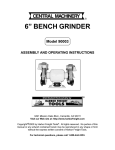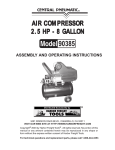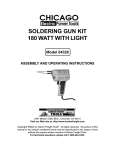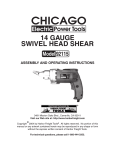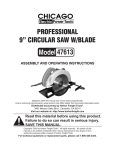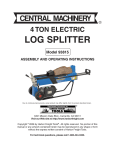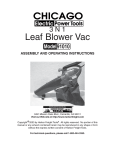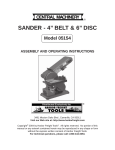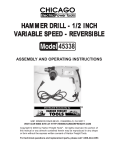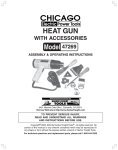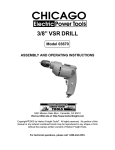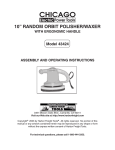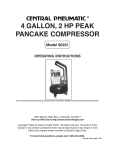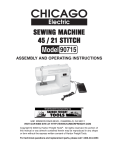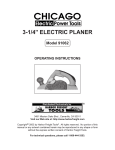Download Harbor Freight Tools 90234 Air Compressor User Manual
Transcript
® COMPRESSOR 4 HP - 10 GALLON Model 90234 OPERATING INSTRUCTIONS ® 3491 Mission Oaks Blvd., Camarillo, CA 93011 Visit our Web site at: http://www.harborfreight.com Copyright 2003 by Harbor Freight Tools®. All rights reserved. No portion of this manual or any artwork contained herein may be reproduced in any shape or form without the express written consent of Harbor Freight Tools. For technical questions, please call 1-800-444-3353. PRODUCT SPECIFICATIONS Item Description Electrical Requirements 4 HP Peak / 3 HP Rated / 120 V / 60 Hz 3400 RPM; Two Capacitor Motor Thermal Overload Protection Maximum PSI 115 PSI Air Deliveries 4.5 SCFM @ 115 PSI / 5.6 SCFM @ 90 PSI 6.2 SCFM @ 70 PSI / 7.2 SCFM @ 40 PSI Air Tank Capacity 10 Gallons Automatic Shut-Off Automatic Restar t Automatic Shut-Off @ 115 PSI Automatic Restar t @ 85 PSI Oil Capacity 25.35 Ounces Air Outlet Size 1/4"-18 NPT Male Threads Net Weight 75.50 Pounds SAVE THIS MANUAL You will need this manual for the safety warnings and precautions, assembly, operating, inspection, maintenance and cleaning procedures, parts list and assembly diagram. Keep your invoice with this manual. Write the invoice number on the inside of the front cover. Keep this manual and invoice in a safe and dry place for future reference. GENERAL SAFETY RULES WARNING! READ AND UNDERSTAND ALL INSTRUCTIONS Failure to follow all instructions listed below may result in electric shock, fire, and/or serious injury. SAVE THESE INSTRUCTIONS WORK AREA 1. Keep your work area clean and well lit. Cluttered benches and dark areas invite accidents. SKU 90234 PAGE 2 REV 04/04 2. Do not operate power tools in explosive atmospheres, such as in the presence of flammable liquids, gases, or dust. Power tools create sparks which may ignite the dust or fumes. 3. Keep bystanders, children, and visitors away while operating a power tool. Distractions can cause you to lose control. Protect others in the work area from debris such as chips and sparks. Provide barriers or shields as needed. 4. ELECTRICAL SAFETY Grounded tools must be plugged into an outlet properly installed and grounded in accordance with all codes and ordinances. Never remove the grounding prong or modify the plug in any way. Do not use any adapter plugs. Check with a qualified electrician if you are in doubt as to whether the outlet is properly grounded. If the tools should electrically malfunction or break down, grounding provides a low resistance path to carry electricity away from the user. 5. Double insulated tools are equipped with a polarized plug (one blade is wider than the other). This plug will fit in a polarized outlet only one way. If the plug does not fit fully in the outlet, reverse the plug. If it still does not fit, contact a qualified electrician to install a polarized outlet. Do not change the plug in any way. Double insulation eliminates the need for the three wire grounded power cord and grounded power supply system. 6. Avoid body contact with grounded surfaces such as pipes, radiators, ranges, and refrigerators. There is an increased risk of electric shock if your body is grounded. 7. Do not expose power tools to rain or wet conditions. Water entering a power tool will increase the risk of electric shock. 8. Do not abuse the Power Cord. Never use the Power Cord to carry the tools or pull the Plug from an outlet. Keep the Power Cord away from heat, oil, sharp edges, or moving parts. Replace damaged Power Cords immediately. Damaged Power Cords increase the risk of electric shock. PERSONAL SAFETY 9. Stay alert. Watch what you are doing, and use common sense when operating a power tool. Do not use a power tool while tired or under the influence of drugs, alcohol, or medication. A moment of inattention while operating power tools may result in serious personal injury. SKU 90234 PAGE 3 10. Dress properly. Do not wear loose clothing or jewelry. Contain long hair. Keep your hair, clothing, and gloves away from moving parts. Loose clothes, jewelry, or long hair can be caught in moving parts. 11. Avoid accidental starting. Be sure the Power Switch is off before plugging in. Carrying power tools with your finger on the Power Switch, or plugging in power tools with the Power Switch on, invites accidents. 12. Remove adjusting keys or wrenches before turning the power tool on. A wrench or a key that is left attached to a rotating part of the power tool may result in personal injury. 13. Do not overreach. Keep proper footing and balance at all times. Proper footing and balance enables better control of the power tool in unexpected situations. 14. Use safety equipment. Always wear eye protection. Dust mask, non-skid safety shoes, hard hat, or hearing protection must be used for appropriate conditions. TOOL USE AND CARE 15. Do not force the tool. Use the correct tool for your application. The correct tool will do the job better and safer at the rate for which it is designed. 16. Do not use the power tool if the Power Switch does not turn it on or off. Any tool that cannot be controlled with the Power Switch is dangerous and must be replaced. 17. Disconnect the Power Cord Plug from the power source before making any adjustments, changing accessories, or storing the tool. Such preventive safety measures reduce the risk of starting the tool accidentally. 18. Store idle tools out of reach of children and other untrained persons. Tools are dangerous in the hands of untrained users. 19. Maintain tools with care. Keep cutting tools sharp and clean. Properly maintained tools with a sharp cutting edge are less likely to bind and are easier to control. Do not use a damaged tool. Tag damaged tools “Do not use” until repaired. 20. Check for misalignment or binding of moving parts, breakage of parts, and any other condition that may affect the tool’s operation. If damaged, have SKU 90234 PAGE 4 the tool serviced before using. Many accidents are caused by poorly maintained tools. 21. Use only accessories that are recommended by the manufacturer for your model. Accessories that may be suitable for one tool may become hazardous when used on another tool. SERVICE 22. Tool service must be performed only by qualified repair personnel. Service or maintenance performed by unqualified personnel could result in a risk of injury. 23. When servicing a tool, use only identical replacement parts. Follow instructions in the “Inspection, Maintenance, And Cleaning” section of this manual. Use of unauthorized parts or failure to follow maintenance instructions may create a risk of electric shock or injury. GROUNDING WARNING! Improperly connecting the grounding wire can result in the risk of electric shock. Check with a qualfified electrician if you are in doubt as to whether the outlet is properly grounded. Do not modify the power cord plug provided with the tool. Never remove the grounding prong from the plug. Do not use the tool if the power cord or plug is damaged. If damaged, have it repaired by a service facility before use. If the plug will not fit the outlet, have a proper outlet installed by a qualified electrician. GROUNDED TOOLS: TOOLS WITH THREE PRONG PLUGS 1. Tools marked with “Grounding Required” have a three wire cord and three prong grounding plug. The plug must be connected to a properly grounded outlet. If the tool should electrically malfunction or break down, grounding provides a low resistance path to carry electricity away from the user, reducing the risk of electric shock. (See Figure A, next page.) 2. The grounding prong in the plug is connected through the green wire inside the cord to the grounding system in the tool. The green wire in the cord must be the only wire connected to the tool’s grounding system and must never be attached to an electrically “live” terminal. (See Figure A.) SKU 90234 PAGE 5 3. Your tool must be plugged into an appropriate outlet, properly installed and grounded in accordance with all codes and ordinances. The plug and outlet should look like those in the following illustration. (See Figure A.) FIGURE A DOUBLE INSULATED TOOLS: TOOLS WITH TWO PRONG PLUGS 4. Tools marked “Double Insulated” do not require grounding. They have a special double insulation system which satisfies OSHA requirements and complies with the applicable standards of Underwriters Laboratories, Inc., the Canadian Standard Association, and the National Electrical Code. (See Figure B.) 5. Double insulated tools may be used in either of the 120 volt outlets shown in the following illustration. (See Figure B.) FIGURE B SKU 90234 PAGE 6 SYMBOLOGY Double Insulated Canadian Standards Association Underwriters Laboratories, Inc. V~ A no xxxx/min. Volts Alternating Current Amperes No Load Revolutions per Minute (RPM) SPECIFIC SAFETY RULES 1. Maintain a safe working environment. Keep the work area well lit. Make sure there is adequate surrounding workspace. Always keep the work area free of obstructions, grease, oil, trash, and other debris. Do not use this product in areas near flammable chemicals, dusts, and vapors. 2. Maintain labels and nameplates on the Air Compressor. These carry important information. If unreadable or missing, contact Harbor Freight Tools for a replacement. 3. Use eye and hearing protection. Always wear ANSI approved safety impact eye goggles and hearing protectors when using this product. 4. Do not allow children to use or play with this product. 5. Store idle equipment. When not in use, tools and equipment should be stored in a dry location to inhibit rust. Always lock up tools and equipment, and keep out of reach of children. 6. Do not use this product if under the influence of alcohol or drugs. Read warning labels on prescriptions to determine if your judgement or reflexes are impaired while taking drugs. If there is any doubt, do not attempt to use this product. 7. Make sure to fill the Air Compressor with a premium quality, 30-weight, non-detergent, compressor oil before each use. Running the Air Compressor with no oil or low oil will cause damage to the equipment and void the warranty. SKU 90234 PAGE 7 8. When checking the oil level, make sure to unscrew (do not pull) the Oil Plug (part #78) out. 9. Drain the Air Compressor’s Tank (part #50) every day. Do not allow moisture to build up inside the Tank. Do not open the Tank Drain Valve (part #59) so that more than four threads are showing. 10. Avoid injury. Never direct the Air Outlet Valve (part #69) at people or animals. 11. Do not alter or remove the factory sealed Pressure Relief Valve (part #67). 12. Dress properly. Do not wear loose clothing or jewelry as they can be caught in moving parts. Wear restrictive hair covering to contain long hair. 13. Do not overreach. Keep proper footing and balance at all times. Do not reach over or across running machines. 15. Industrial applications must follow OSHA requirements. 16. Maintain this product with care. Keep this product clean for better and safer performance. 17. Maintenance: For your safety, service and maintenance should be performed regularly by a qualified technician. 18. Check for damaged parts. Before using this product, carefully check that it will operate properly and perform its intended function. Check for damaged parts and any other conditions that may affect the operation of this product. Replace or repair damaged or worn parts immediately. 19. Replacement parts and accessories: When servicing, use only identical replacement parts. Only use accessories intended for use with this product. 20. Use the right tool or attachment for the job. Do not attempt to force a small tool or attachment to do the work of a larger industrial tool or attachment. There are certain applications for which this product was designed. It will do the job better and more safely at the rate for which it was intended. Do not modify this product, and do not use this product for a purpose for which it was not intended. 21. To extend the life of your air tools and equipment: It is recommended to install a water filter and oiler (available from Harbor Freight Tools) in series with the Air Outlet Valve (part #69) of the Air Compressor. (See Figure C, next page.) SKU 90234 PAGE 8 22. WARNING! People with pacemakers should consult their physician(s) before using this product. Operation of electrical equipment in close proximity to a heart pacemaker could cause interference or failure of the pacemaker. 23. WARNING! The warnings, precautions, and instructions discussed in this manual cannot cover all possible conditions and situations that may occur. The operator must understand that common sense and caution are factors which cannot be built into this product, but must be supplied by the operator. AIR OUTLET VALVE (#69) TO AIR TOOL WATER FILTER OILER FIGURE C UNPACKING When unpacking, check to make sure all the parts shown on the Parts List on pages 14 and 15 are included. If any parts are missing or broken, please call Harbor Freight Tools at the number shown on the cover of this manual as soon as possible. OPERATING INSTRUCTIONS NOTE: For additional information regarding the parts mentioned in the following pages, refer to the Assembly Diagram on page 16. 1. IMPORTANT! Always fill the Air Compressor with a premium quality, SKU 90234 PAGE 9 30-weight, non-detergent, compressor oil before each use. Running the Air Compressor with no oil or low oil will cause damage to the equipment and void the warranty. To check the level of oil, make sure the Air Compressor is OFF. Then, observe the Oil Level Window (part #72). The level of oil should just reach the horizontal line as shown on the Oil Level Window. If the level of oil is below the horizontal line, remove the Oil Plug (part #78) and add new oil through the Oil Plug hole. Make sure not to overfill. The Air Compressor is designed to hold approximately 25 fluid ounces of oil. Then screw in the Oil Plug, being careful not to strip the threads. (See Figure D.) OIL PLUG (#78) OIL LEVEL WINDOW (#72) PRESSURE RELIEF VALVE (#67) FIGURE D 2. Turn the Air Outlet Valve (part #69) to its CLOSED position. Then connect a high pressure air hose (not included) equipped with a quick connector to the Air Outlet Valve. If using a water filter and oiler in series with the Air Outlet Valve of the Air Compressor, connect the other end of the air hose to the water filter and oiler and connect the water filter and oiler to the air tool being used. If not using a water filter and oiler, squirt several drops of air tool oil into the air intake plug of the air tool. Then, connect the other end of the air hose directly from the Air Outlet Valve of the Air Compressor to the air tool. (See Figure E, and Figure F, next page.) CLOSED POSITION OPEN POSITION AIR OUTLET VALVE (#69) CONNECT AIR HOSE HERE. FIGURE E SKU 90234 PAGE 10 REV 04/04 3. Make sure the Tank Drain Valve (part #59) is closed. (See Figure F.) 4. Make sure the “On/Off” Pressure Switch (part #66) is DOWN in its OFF position. Then, plug the Power Cord (part #64) into the nearest 120 volt, grounded, electrical outlet. (See Figure F.) 5. Pull UP on the “On/Off” Pressure Switch (part #66) to its ON position. (See Figure F.) “ON/OFF” PRESSURE SWITCH (#66) PRESSURE REGULATOR (#70) AIR OUTLET VALVE (#69) TANK PRESSURE GAUGE AIR OUTLET (#65) PRESSURE GAUGE (#71) FIGURE F TANK DRAIN VALVE (#59) AIR HOSE (NOT INCLUDED) ATTACH TO AIR TOOL. 6. Allow the Air Compressor to build up from 85 PSI to 115 PSI as indicated on the Tank Pressure Gauge (part #65). When the air pressure reaches 85 PSI, open the Air Outlet Valve (part #69) to allow the air hose and air tool to become pressurized. (See Figure F.) 7. As long as the “On/Off” Pressure Switch (part #66) is in its ON position the operation of the Air Compressor is automatic, controlled by an internal pressure switch. The Air Compressor will turn on automatically when the air pressure drops to 85 PSI as indicated on the Tank Pressure Gauge (part #65), and will turn off automatically when the air pressure reaches 115 PSI as indicated. IMPORTANT: The internal pressure switch is adjustable, but changes to the air pressure levels should not be done. Any change to the automatic pressure levels will cause additional stress on the motor which may result in shortened motor life and will void the warranty. (See Figure F.) SKU 90234 PAGE 11 8. Turn the Pressure Regulator (part #70) counterclockwise to increase the amount of compressed air to the air tool being used (from 90 PSI to 115 PSI). Turn the Pressure Regulator clockwise to decrease the amount of compressed air. (See Figure F.) 9. NOTE: If it is necessary to quickly depressurize the Air Compressor, turn off the Air Compressor by pushing DOWN on the “On/Off” Pressure Switch (part #66). Then, pull OUT on the ring on the Pressure Relief Valve (part #67) to quickly release stored air pressure. (See Figure D.) 10. When finished using the Air Compressor, turn it off by pushing DOWN on the “On/Off” Pressure Switch (part #66). Unplug the Power Cord (part #64) from its electrical outlet. Squeeze the trigger on the air tool being used to release all stored air pressure from the system, and disconnect the air hose and air tool from the Air Compressor. Then, open the Tank Drain Valve (part #59) to release all remaining compressed air from the Air Tank (part #50). (See Figure F.) 11. NOTE: The Air Compressor is equipped with an internal overload device. Should the Air Compressor overheat while in use, the machine will automatically shut down. If this happens, push DOWN on the “On/Off” Pressure Switch (part #66). Wait five to ten minutes. Press the Overload Button (part #31). Then, pull UP on the “On/Off” Pressure Switch to restart the Air Compressor. (See Figure G.) FIGURE G OVERLOAD BUTTON (#31) SKU 90234 PAGE 12 INSPECTION AND MAINTENANCE 1. WARNING! Always unplug the Air Compressor from its electrical outlet before performing any inspection, maintenance, or cleaning. 2. Before each use: Inspect the general condition of the Air Compressor. Check for misalignment or binding of moving parts, cracked or broken parts, damaged wiring, damaged air hose, and any other condition that may affect its safe operation. If abnormal noise or vibration occurs, have the problem corrected before further use. Do not use damaged equipment. 3. Daily: Make sure the level of compressor oil is adequate. For instructions on checking and, if necessary, filling the Air Compressor with oil see pages 9 and 10 of this manual. 4. Daily: Purge the Tank (part #50) daily of all air and moisture to prevent corrosion. To do so, unscrew the Tank Drain Valve (part #59) two to three turns. Do not unscrew the Tank Drain Valve more than three turns. When all the air pressure and moisture is released from the Tank, retighten the Tank Drain Valve. (See Figure F.) 5. Store the Air Compressor in a clean, dry, location. PLEASE READ THE FOLLOWING CAREFULLY THE MANUFACTURER AND/OR DISTRIBUTOR HAS PROVIDED THE PARTS LIST AND ASSEMBLY DIAGRAM IN THIS MANUAL AS A REFERENCE TOOL ONLY. NEITHER THE MANUFACTURER OR DISTRIBUTOR MAKES ANY REPRESENTATION OR WARRANTY OF ANY KIND TO THE BUYER THAT HE OR SHE IS QUALIFIED TO MAKE ANY REPAIRS TO THE PRODUCT, OR THAT HE OR SHE IS QUALIFIED TO REPLACE ANY PARTS OF THE PRODUCT. IN FACT, THE MANUFACTUER AND/OR DISTRIBUTOR EXPRESSLY STATES THAT ALL REPAIRS AND PARTS REPLACEMENTS SHOULD BE UNDERTAKEN BY CERTIFIED AND LICENSED TECHNICIANS, AND NOT BY THE BUYER. THE BUYER ASSUMES ALL RISK AND LIABILITY ARISING OUT OF HIS OR HER REPAIRS TO THE ORIGINAL PRODUCT OR REPLACEMENT PARTS THERETO, OR ARISING OUT OF HIS OR HER INSTALLATION OF REPLACEMENT PARTS THERETO. SKU 90234 PAGE 13 PARTS LIST Part # Description Qty. Part # Description Qty. 1 Bolt 4 25 Washer 2 2 Cylinder Head 1 26 Terminal 7 3 Cylinder Cover Washer 1 27 Nylon Band 2 4A Bolt 2 29 Bolt 4 4B Exhaust Valve Plate Spacer 1 30 Holder 2 4C Exhaust Valve Plate 1 31 Overload Button 2 4D Valve Seat 1 34 Shaft Oil Seal 1 5 Column Pin 2 35 Bearing 1 6 Inlet Valve Plate 1 36A Motor Stator 1 7 Cylinder Up Washer 1 36B Motor Rotor 1 8 Cylinder 1 37 Bearing 1 9 Cylinder Down Washer 1 38 Wave Washer 1 10A Piston Air Ring 2 39 Ele. Motor Back Cover 1 10B Piston Oil Ring 1 40 Bolt 1 11 Retaining Ring In Hole 2 41A Centrifugal Switch Plate 1 12 Piston 1 41B Centrifugal Switch 1 13 Piston Pin 1 42 Bolt 2 14 Connect Rod 1 43 Centrifugal Seat Washer 2 15 Crankcase 1 44 Centrifugal Cover 1 16 Crankshaft 1 45 Bolt 4 17 In-Six Angle Bolt 1 46 Fan 1 18 Rubber Washer 4 47 Retaining Ring In Shaft 2 19 O-Ring 1 48 Bolt 4 20 Bolt 1 49 Bolt 4 21 Star ting Capacitor 1 50 Air Tank 1 22 Running Capacitor 1 51 Washer 4 23 Nut 2 52 Nut 4 24 Saw Washer 2 53A Tank Wheel 2 SKU 90234 PAGE 14 PARTS LIST (CONTINUED) Part # Description Qty. Part # Description Qty. 53B Tank Wheel Cover 2 68 Nipple 1 54 Retaining Ring In Shaft 2 69 Air Outlet Valve 1 55 Exhaust Elbow 1 70 Pressure Regulator 1 56 Exhaust Copper Tube Assy. 1 71 Air Outlet Pressure Gauge 1 57 Check Valve 1 72 Oil Level Window 1 58 Unload Copper Tube Assy. 1 73 Oil Level Window Seal 1 59 Tank Drain Valve 1 74 Bolt 6 60 In-Six Angle Bolt 1 75 Spring Washer 1 61 Foot Rubber Pad 1 76 Crankcase Front Cover 1 62 Washer 1 77 Crankcase Front Seal 1 63 Nut 1 78 Oil Plug 1 64 Power Cord 1 80 Handle 1 65 Tank Pressure Gauge 1 81 In-Six Angle Bolt 4 66 Pressure Switch 1 82 Motor PV Cover 1 66A Nipple 1 83 Bolt 1 66B Five-Route Way 1 84 Bolt 2 67 Pressure Relief Valve 1 85 Air Filter 2 SKU 90234 PAGE 15 NOTE: Some parts are listed and shown for illustration purposes only, and are not available individually as replacement parts. ASSEMBLY DIAGRAM SKU 90234 PAGE 16
















